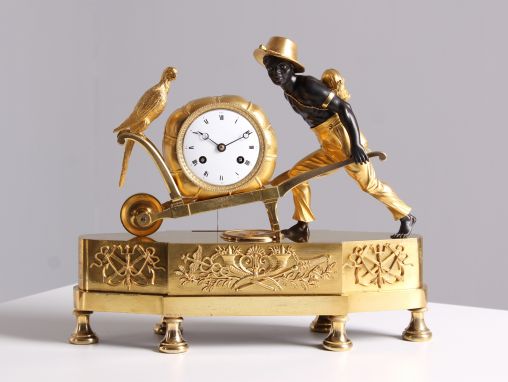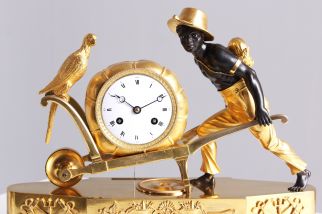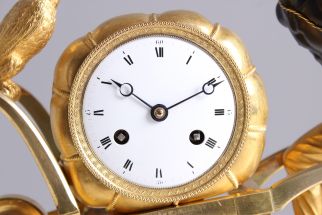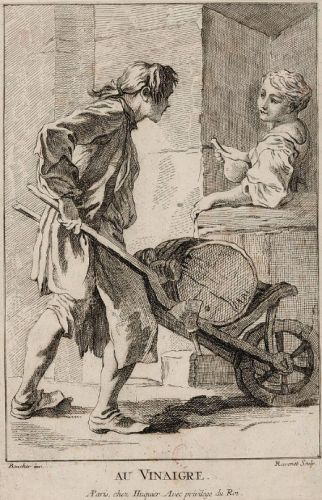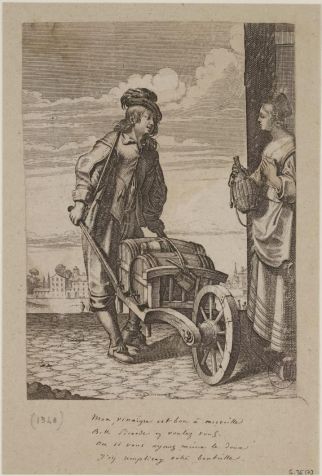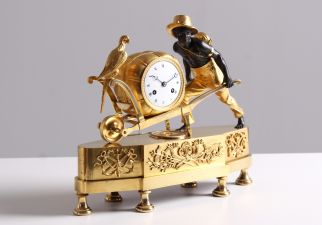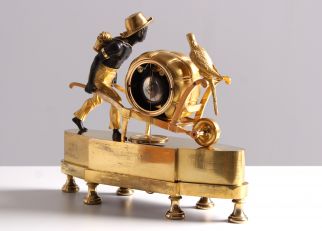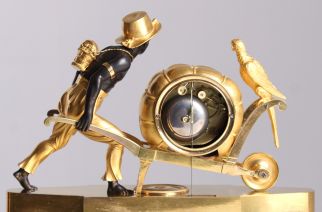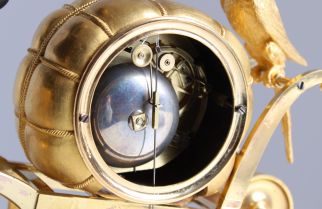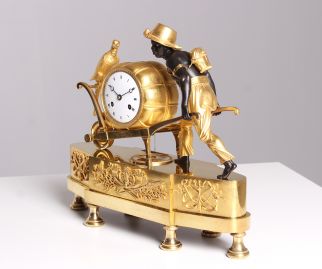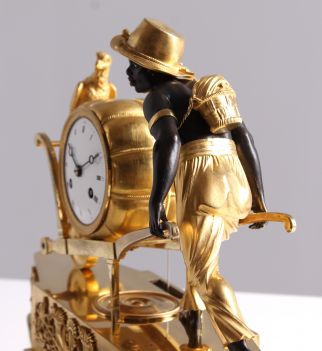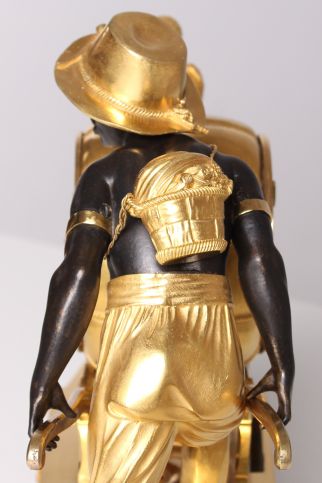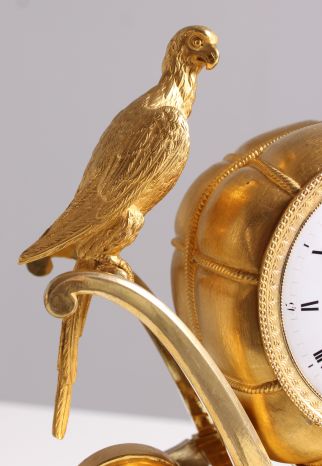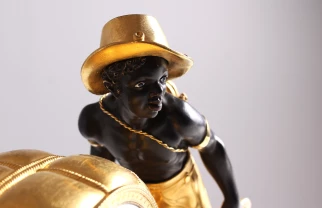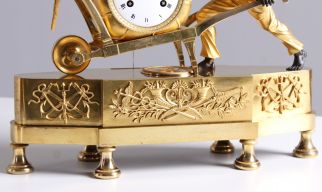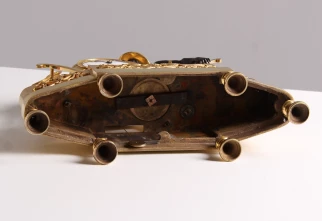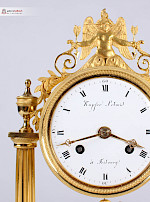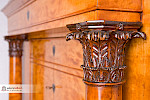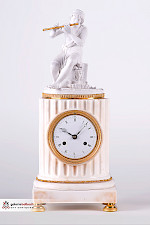Very rare "Au Bon Sauvage" mantel clock
France
Fire-gilt and patinated bronze
Empire around 1810
Dimensions: H x W x D: 34 x 41 x 13 cm
Description:
Extremely rare French bronze mantel clock from the early 19th century in marvellous condition.
The central pedestal relief shows cornucopias and laurel tendrils as well as a caduceus - or Mercury's staff - symbolising trade and a paddle symbolising seafaring. Both allude to the flourishing trade with the French colonies. The corner appliqués also pick up on this theme with an anchor, rope and trident.
However, the main focus is on the fully sculpted bronze depiction above. It depicts a young man pushing a wheelbarrow with a bale of cotton. A parrot sits on the front of the barrow. The clockwork is embedded in the bale and the pendulum swings through an opening under the base.
The high quality of the bronze work and the balance of the overall composition are impressive. The dark patination of the body contrasts wonderfully with the original fire gilding and the white of the enamelled dial.
The 8-day pendulum movement strikes a bell on the half and full hour. The thread suspension of the pendulum and the lock disc striking mechanism are typical of the period.
Interesting facts:
The model shown here with the wheelbarrow was probably designed shortly after the Portefaix. The Portefaix is the best-selling clock from the "Au bon Sauvage" model series today and was also the best-selling clock back then. The figure of both models is identical, except for the position of the arms. Nevertheless, the clock with the wheelbarrow could not compete with the Portefaix in terms of sales figures.
The Journal des Dames et des Modes reported on the great success of the Portefaix in October 1807 and then wrote two months later: "Inspired by the great success of the pendulum clock (Portefaix), which consists of a bale of cotton transported on a wheelbarrow, the bronze dealers imagined that a clock with the bale placed on a wheelbarrow would be a second bestseller. But the wheelbarrow became a slow seller."
If you look at the examples of the wheelbarrow that have survived to this day, however, you come to the conclusion that this clock also found its buyers. However, it was obviously produced in much smaller numbers than the Portefaix and is therefore very rare in the art trade today.
The motif of the cart actually originates from the everyday life of ordinary people in Paris. Merchants and craftsmen travelled the streets shouting and singing, offering their goods and services. The romanticised lifestyle of the shouting merchants made them a popular motif in art. Copperplate engravings by Abraham Bosse (1604-1676) and François Boucher (1703-1770), among others, are already known from the 17th and 18th centuries, showing vendors with a barrel of vinegar on a wheelbarrow.
Meissen also took up the motif of calling merchants in the mid-18th century and published a 35-piece series of porcelain figurines under the name "Cris de Paris", including a vinegar seller.
After the great success of the Portefaix, a related, highly marketable motif was sought and found in the vinegar seller, whose depiction was now used in an exotically modified form.
Condition:
Wonderful, authentic condition. The movement has been overhauled and works perfectly.
There is an old repaired spot on the rear carrier of the wheel axle. Technically this is well done. The spot is clearly visible in the photo showing the back of the watch.
Price: 19000,-€
This model can be found in various reference books:
Pierre Kjellberg - Encyclopédie De La Pendule Francaise p. 344
Musée Francois Duesberg p. 67
Jean-Dominique Augarde - Une Odyssée En Pendules II p. 446
Article found under: Clocks
Add to shopping cartVideo Empire mantel clock
Also interesting
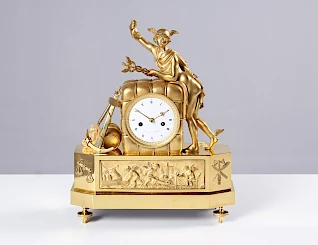
Pendule - Mercury the messenger of the gods
France
Bronze gilt
Empire around 1815
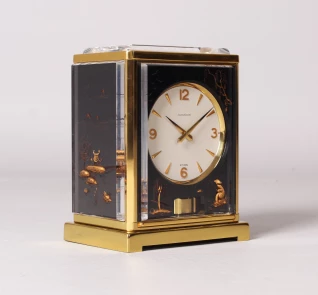
Jaeger LeCoultre - Atmos "Chinois
Switzerland
Brass, plexiglass
Year of manufacture 1965
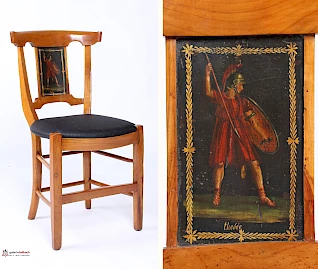
Set of four very unusual chairs
Bourgogne (France)
Cherry tree, oil paint
Directoire around 1800
